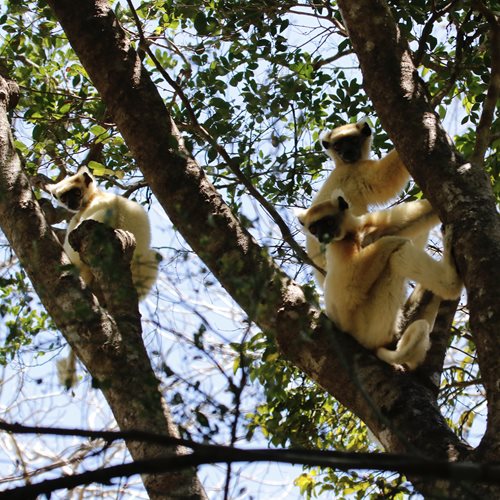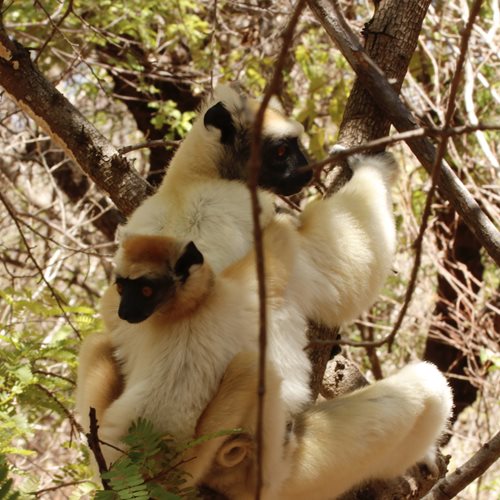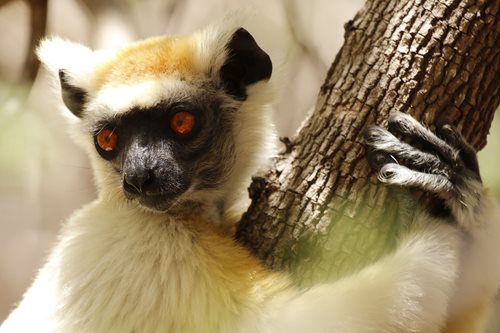We’d organised a fairly up-market tourist trip focussed on trying to see a good range of Madagascar’s wildlife, and our lovely guide and minder held fairly strong ideas about what kind of accommodation was good enough for us. It didn’t matter that we’d been on expeditions, been intrepid,
were intrepid.
It was now early October and for this part of the trip, we began in Vohemar. This is a port on Madagascar’s eastern seaboard. It seemed to have quite a population of expat Frenchmen with local girlfriends looking 30 years younger. There was money here, at centre of the vanilla industry. Although vanilla is an orchid and there are plenty of orchids endemic to Madagascar, the epiphytic vanilla species that is cultivated as a cash crop is Mexican and in Madagascar it has to be tenderly hand-pollinated by humans in tiny corners of land. The industry is said to earn about 9% of the country’s capital from exports. With Vohemar’s big tree-lined avenues, I could see the attractions of living here: we too enjoyed sea views from the balcony of our rooms, French wine and delicious cuisine.
We drove west from Vohemar, leaving the verdant, high-rainfall region for denuded hills and parched savannahs. We were bound for two patches of dry deciduous forest, veritable ecological islands, surrounded not by water but by over-grazed grasslands. Our first stop was in the small town of Daraina where we needed to collect a permit to enter the Loky – Manambato Protected Area. While the relevant official and the correct documents were found we took a wander around the fruit market and pondered whether mangoes were too messy to eat in the car. A small boy was staring at me but when I bent down to be friendly, he froze with fear – too scared, it seemed, even to run away. As tears tumbled from his eyes, I wondered what terrifying stories the boy had been fed about
vazas like me
.
After a short discussion about where we were going to stay next, we drove on, beneath a baobab horizon and then into the Protected Area, arriving at what would have been the best accommodation in the middle of the reserve but it had been trashed by cyclones.
We tumbled out of the vehicle and had hardly left the so-called Tattersall camp when our local guide, Amadou, led us to a patch of scrubby vegetation. As we approached, I clocked animals browsing on the bushes that still bore leaves and realised that these were local zoological stars we’d come to admire. I was a little concerned though when Amadou approached from a hummock that looked down on them. Usually threats from above spook wild animals but these hardly glanced at us.
They represent the lemur genus with an alarm call that sounds like a sharp intake of breath follow by an obscenity so these are known as Si-faka, and these were Golden Crowned Sifaka. They are mostly white, and have orange eyes to match their crowns. They weigh about three-and-a-half kilos. Several females carried babies on their backs. Amadou explained that these individuals had been habituated to human company by the zoologists who first studied them. The species had been previously unknown to science, and were only first described in 1982. They constitute an estimated population of only about 2000. Happily these Golden Crowned Sifaka seemed totally blazé about our presence and continued browsing on leaves which is essentially all they eat.
It was astonishing to be able to wander quite close and take in how their bodies are perfectly suited to their elegant upright posture. They don’t scamper along branches but leap using their powerful back legs, and land back-legs first. Their feet are disproportionately huge but like other lemurs the ‘big toe’ is separate from the other toes, and the thumb is also opposable, as in all primates.
 |
| Chilling Golden Crowned Sifaka |
 |
| A Golden Sifaka - mum and babe |
 |
| One of the most endearing lemurs, and one of the most threatened |
Amadou next took us into the forest proper and pointed out a Sportive Lemur drowsing in a crack in the bark of a big tree, a Madagascar hissing cockroach, plenty of chameleons, a saucer-sized spider and various well-camouflaged geckos. We also quickly encountered another troop of Sifaka: dappled sunlight filtering through leaves made their golden crowns positively gleam. We sat for ages watching them browse, and groom each other, and move on in search of other succulent titbits. Some just lounged about, back against a tree-trunk, huge feet, one crossed over the other propped up on a branch. Further on, one Sifaka was hanging from a leg and an arm plucking fleshy white flowers from the very tips of slender branches.
I was also heartened to meet another population of Crowned Lemurs. At just over a kilo in weight they looked small compared to the Sifakas. When we completed the first study of Crowned Lemurs in the wild, it looked as if they were pretty much restricted to the forests of Ankarana and to neighbouring Montagne d’Ambre. But they were clearly thriving here too, perhaps 40km as the vanga flies but a couple of hours driving east of Ankarana. Crowned Lemurs (which weigh a little over one kilogram) are canny animals and seem to be able to range along forest corridors which make this species resilient to forest fires and other threats.
It felt such a privilege to sit with the Golden Crowned Sifakas and the Crowned Lemurs in their forest home watching them contentedly browse. Amadou took his leave but suggested we take a leisurely lunch and rest in the heat of the day, and then we’d head back into the forest at sundown. As in Marojejy, two
pisseurs or spotters would then take us the meet yet more celebrities.
We set off again at around 5pm and began from a dusty track. Amadou said we would reach the forest by way of the
tsingy noire.
Tsingy is Malagasy for walking on tiptoes which is supposedly the way to navigate sharply eroded white limestone terrain, but as we summitted a slight rise in the savannah, he swept his arm towards an underwhelming scattering of black basalt boulders. Charging on though he did point out a sickle-billed vanga, and a Chalbert’s vanga – representatives of an entire family of endemic birds. Next he showed us three different species of huge water-storing baobab trees. I thought this brilliant since there are only nine species in the entire world: one from Australia, two from Africa and six from Madagascar. They are actually super-evolved hibiscus or mallow plants with barrel like trunks and which are extraordinarily long-lived; one individual is known to be at least 1000 years old.
Heading into a different forest patch, tiny Fork-marked Lemurs were shouting their head off. Despite their advertisements saying plenty were watching us, I didn’t manage to see any. Amadou told us to sit and wait beneath a leafy construction that looked like a squirrel’s drey perhaps 10m above us. Our quarry was the misunderstood nocturnal aye-aye. These lemurs have big mobile ears, teeth like a beaver, a long, grizzled coat, bushy tail and weird skeletal fingers which they use to percuss timber to detect prey then winkle out big juicy high-protein grubs. Their faces are rather reminiscent of gargoyles and some Malagasy people believe they bring bad fortune. Perhaps that is why aye-ayes only emerge to nibble leaves after dark, and they also build several dreys and move house often. Amadou’s
pisseurs knew there was someone home and all we needed to do was to wait and watch.
A shaggy animal emerged at about 6.30, and wandered along a horizonal branch in search of food. As it nibbled with its bony fingers wrapped around some leafy treasure, I thought of Gollum, and immediately chastised myself for being disrespectful. We were in the presence of one of the world’s rarest mammals, weighing about two-and-a-half kilograms, known for being secretive. I’d never imagined I’d ever have the privilege of seeing one in the wild. Then a second aye-aye emerged and – well words failed me, and still do.
Tired, dry, stiff-necked but satisfied, we ambled back to the cars, stumbling a bit in the dark, and drove back to Daraina town and the Hotel Lemurien Blanc to discover there was no water to shower in or even flush the loos but there was cold Three Horses Beer, so what else could we do but celebrate a totally awesome day of lemur-watching?
And the following day we’d drive on, a little further west, to another ecological island: Andrafiamena Andavakoera.
This is one of several blogs about this trip to northern Madagascar during autumn 2024. Start with the first here
Return to Ankarana